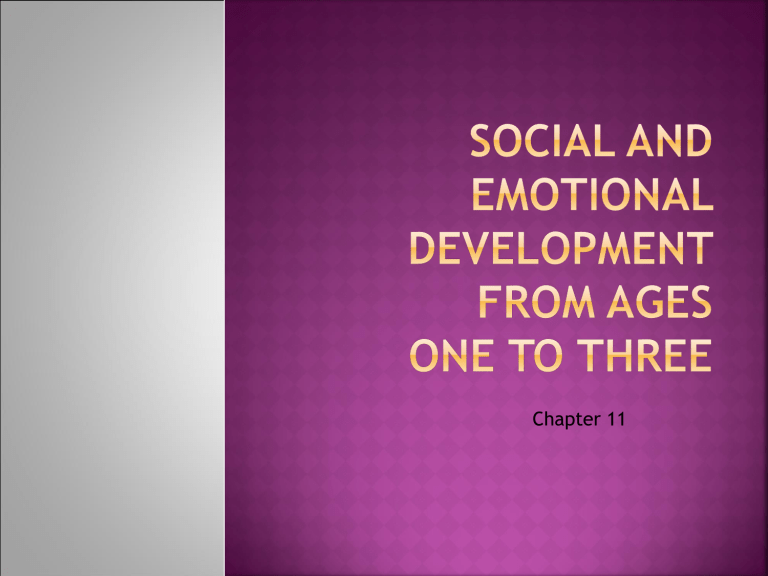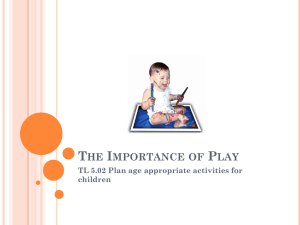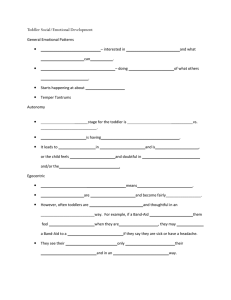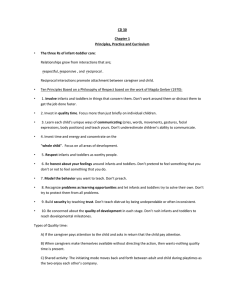
Chapter 11 •Describe patterns of emotional development from ages one to three •Identify common emotions of young children and the changing ways they express those emotions •Analyze how individual differences affect emotional development •Explain how self-concept develops Eighteen Months Children at this age are self-centered---think about their own needs and wants and not of others Spoken instructions are not successful with children of this age. Negativism—doing the opposite of what others want is normal for toddlers. Caused by: •Desire for independence •Frustration •Realization of being a separate person When dealing with negativism, parents and caregivers should give positive guidance. •Give choices (limit number) •Redirect the child •Encourage talking At eighteen months, many children start to have temper tantrums. This is where children release anger or frustration by screaming, crying, kicking, pounding or holding their breath. Two Years Speech and motor skills have improved so children are less frustrated. Children are able to understand more and wait longer for their needs to be met. Children of this age have fewer emotional outbursts and are easier to reason with. Children usually get along better with other children and adults. They are more outgoing, friendly and less self-centered. Two and one half years This becomes a more challenging time with children. They are not easily distracted. At this age, children are learning so much they become overwhelmed. Their senses take in more than they can comprehend. Children at this age they have a strong drive for independence and do not like being bossed around, shown how to do things or helped in any way. Children at this age have extreme mood changes. They will go from lovable to stubborn in seconds. Consistency is important. Routines are important in keeping their moods even. Three Year Old Three year olds are generally happy and cooperative and learning to be considerate. They are finally willing to take directions from others and will do anything for praise and affection. At this age, children love to talk. They talk to anyone and anything. Three and one half year olds These children are suddenly very insecure. Parents feel that their child may be going backward instead of forward emotionally. Fears are very common at this age: •Fear of the dark •Fear of monsters •Fear of strangers •Fear of noises This is also the age that some children may develop “bad habits” like hitting, thumb sucking, nail biting and nose picking. Biting and Hitting Some parents provide plastic inflatable punching bags for children who hit when they are angry. Is this a good idea because it is a safe way of physically venting anger? Is it a bad idea because it reinforces hitting? ANGER This is the child’s way of reacting to frustration. Young toddlers show their anger by hitting and kicking. Older toddlers are more Verbal (name calling and pouting. As a child gets older, they start to direct their anger toward the person they are angry with. A child who has no self control is more likely to have angry outburst. It is very important for parents and caregivers to react in controlled manner so the situation doesn’t escalate. FEAR Children experience different fears at different ages. Sometimes fear is a good thing because it keeps children out of dangerous situations. Sometimes adults project their own fears on to their children. Separation Anxiety is common for children of this age. Parents need to remember this is something a child will grow out of---but it may take awhile. Children who feel separation anxiety, may also have trouble sleeping at night because of their fear. Suggestions For Dealing With Fears of Toddlers 1. Offer support and understanding. Don’t make them feel bad about being afraid. 2. Encourage the child to talk about their fears and listen to them. 3. Read books together about a child who experiences the same fear. It will make your toddler feel better about being afraid. 4. Discuss new experiences before they happen. This way the child will know what to expect. Jealousy This usually starts to occur in the second year of life. Children resent any show of affection between parents. Sibling Rivalry—competition between brothers and sisters for parents’ affection and attention—is common. Fear of losing the parent’s love is what brings on the behavior. Ways to Cut Down on Sibling Rivalry Make sure your children know that you love and appreciate them. Set aside special (one-on-one) time with them each day. Avoid comparing one child to another. Don’t allow children to tattle on one another. Love and Affection Young children must learn to love because their relationships in the younger years forms the basis of their love and affection in later life. A child’s first love is for their caregivers and then expands to those around them. It is important that parent don’t smother their child. This will make it harder to form relationships in the future. Empathy This is the ability to oneself in another’s place. Between the ages of 1 year and 18 months, children start to understand their actions can hurt others. Parents and caregivers can help children to develop empathy by teaching them manners----say your sorry Not all children will develop emotions in the same manner. Experiences have a big impact on how children react. Temperament also plays a big role in how a child develops emotionally. Never expect two children to act the same. Never compare children’s reactions. As children grow, they become aware of the special traits that make them different from others. Self Concept is how a child see themselves. A child forms his self-concept in response to actions, attitudes, and comments of others. Since parents spend a great deal of time with children, they have a big impact on their self-concept development. The years from age 1-3 are critical in a child’s development of self-concept. Children believe what people say about them and act the part. The ability to master skills also affects a child’s selfconcept. It is important to challenge children but not give them things that will not be successful with. How can I tell if my child is developing well emotionally? The most important clue is the child’s relationship with his/her parents. The early relationships will determine patterns of relationships for life. Signs of a Healthy Relationship 1. Child seeks approval and praise from parents 2. Child turns to parents for comfort and help 3. Child tells parents significant events (joy and sorrow) 4. The child accepts limits and discipline without resistance Describe patterns of social development from ages 1-3. Explain how children make friends. Give principles for guiding toddlers. Most children gradually learn to get along with other people, first in their own families and then in groups. This process is called socialization. Through this process children learn social skills. 18 Months At this age there is little real interaction— even when children are playing together. At this age children engage in parallel play. Children tend to treat others as objects and not humans. Child can understand their actions affect others---hit with toy. 2 Years Children at this age are very good at understanding and interacting with their caregivers. Since their speech is developing, they are better able to communicate. Although they may begin to interact while playing, they still primarily engage in parallel play. They want to please others and MAY put someone else’s needs before their own. 2 ½ Years The child’s negativism carries into their social relationships. May refuse to do things for one person but not another. They are beginning to learn about the rights of others but generally are only concerned with what is fair to them. Children often fight, but make up just as quickly. They forgive and forget easily. 3 Years Children of this age are very happy and it shows in their relationships with others. These children will share, help and do things another’s way just to please them. Children this age begin cooperative play. They like to work with others to accomplish something (building, coloring, puzzles) 3 ½ Years By this time, children become more complex in their play and include a lot of conversation. Because they like to play with others, they are more likely to share. Children like to use different strategies to solve their problems (with people and toys). Children begin to form friendships that exclude others. Children begin to compare themselves to others---not always a good thing. Making Friends The ability to make friends is important to normal social development If a child has at least one friend, they are developing normally. If a child has no interest in friends, try to find the root of the problem and work from there. The ability to make friends may be dependent upon the number of experiences a child has had in the past (socialization). If a child had only had interaction with adults, they will have a much harder time related to children their own age. If two children are having a confrontation, the caregiver should only step in if there is physical danger or the children or not evenly matched. Otherwise, children need to learn to work out their differences themselves. Imaginary Friends It is normal for children to have imaginary friends. Some imaginary friends may be around for a few weeks others for months. Imaginary friends can be good things. They help children experiment with their feelings and work out their negative feelings. Parents should only be concerned about imaginary friends if they continue into the teen age years. Guiding Toddlers The purpose of guidance is to help children learn self-discipline. This is the ability to control their own actions. Guidance techniques should be age and developmentally appropriate. Guidance Techniques 8-12 months distraction 2-3 yrs Spoken command 12-15 months Distraction Explanation Reasoning Physical removal 15-24 months Distraction Removal Spoken restrictions 3-4 yrs Reasonable, loving guidance accepted easily Promoting Sharing This is one of the first social skills children learn. Caregivers can help children learn in many ways. •Lead children to activities where they need to practice sharing (sliding board) •Limit the number of materials so sharing is necessary •Have children pass out their own snacks •Be sure they know they are sharing Are quite common among this age group, and there is always a reason When they act out they are trying to communicate why they are upset Biting: Infants bite because they fail to see the difference between a toy or a sibling One year olds bite to see what would happen 2-3 year olds bite to get their way with other children or to get attention, or if they are just angry or frustrated Hitting: Two and three year olds have trouble controlling these impulses or aggressive reactions Children are still self centered and concerned mostly with fulfilling their own needs and desires Hitting kicking and shoving are aggressive behaviors often seen in toddlers Many believe that timeouts are an effective way to help children understand that certain behavior is not acceptable.


